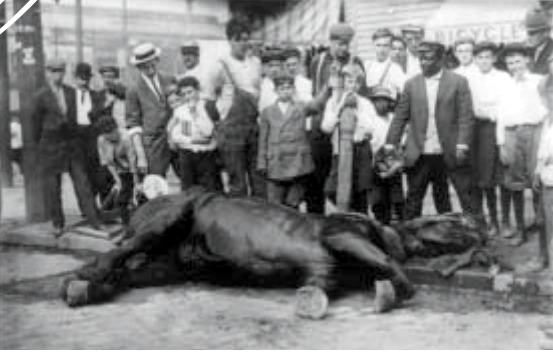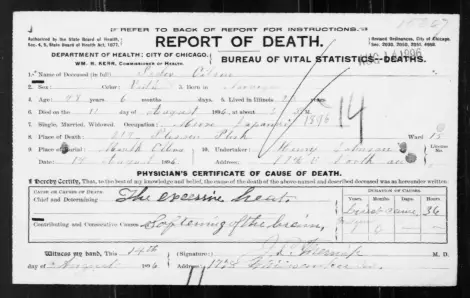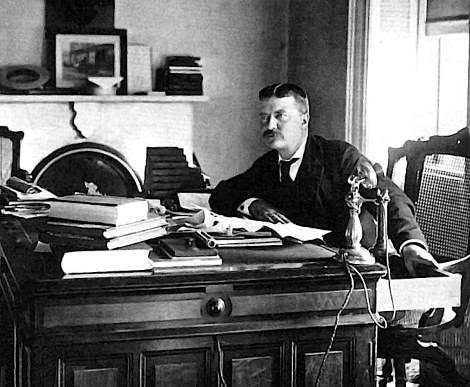When the heat wave of 1896 finally ended on Aug. 13, 1896, it left behind a record of suffering and death “long to be remembered,” reported the Boston Globe.
But the heat wave mostly felled the working poor, and its impact was largely ignored. So was its role in launching Teddy Roosevelt as a progressive politician.
Until, that is, Edward Kohn wrote Hot Time in the Old Town, which credits the heat wave with shaping Theodore Roosevelt’s political career.
Having a Heat Wave
The heat wave, which lasted nearly two weeks, ranked as one of the worst natural disasters in U.S. history.
For 10 days, the temperature soared to 90 degrees and higher, while staying above 70 degrees at night. Humidity hovered at 90 percent, and there wasn’t a breath of wind. Millions suffered without refrigeration or air conditioning from Boston to New York to Chicago.
Reported the Globe,
…No warm wave which has visited this country in recent years has held out longer, has been more continuous in its intensity, or more fatal in its results. Not only has it piled up the death rate to alarming proportions, but it has kept all humanity sweltering in perspiration and maddening heat.
Killer Heat Wave
At first the scorching weather only seemed to kill people who had to work outside all day — mostly Irish laborers who worked as teamsters, longshoremen, blacksmiths and railroad workers.
Then the death toll began to alarm New Englanders. On Monday, August 10, five people died in Providence. On Tuesday, August 11, the Boston Globe reported a “startling list of fatalities from the excessive heat.” Ten died in Boston that day, 20 on Wednesday and 15 on Thursday.
In Holyoke, Mass., some boys playing around a barn noticed a body inside. It belonged to Patrick Curran, a log driver who had probably gone into the barn to sleep. Officials believed the heat killed him and caused his body to decompose after only one day.
Farmers left their fields, public works projects suspended and factories closed. Horses dropped dead in the street, 120 in one day in Boston. (As if the smell of horse manure wasn’t bad enough.) People were found unconscious in coal sheds, in the woods, on the pavement.
There were 19 cases of heat prostration in just one department of a big Waltham, Mass., watch factory on August 10.
No Relief
“No relief yet,” read one headline during the middle of the heat wave. “The sun still continues its terrible work.”
Deaths were reported in Hartford, Providence and New Haven. Temperatures of 97 degrees were registered in Providence, 100 degrees in Springfield, Mass., and 104 degrees in Webster, Mass. It got so hot in Haverhill, Mass., a thermometer burst.
A 48-year-old Boston woman went to visit a neighbor who was overcome by the heat in his blacksmith’s shop. She herself collapsed a few hours later and died.
“All records broken,” reported the Boston Globe. “Almost unbearable on Cape Cod.”
Strange Behavior
People behaved strangely before the heat wave overcame them. Kate Carley, a mill girl in Holyoke, Mass., suddenly lost the power of speech and collapsed. She was taken to the hospital and not expected to recover.
Annie Deckman, a cook at Lander’s restaurant in Boston, was serving dinner when she suddenly dropped an order. The startled patrons watched her walk out of the kitchen. She then went to a room where she used to live. There she was found unconscious. Taken to Massachusetts General Hospital, Deckman died there.
The children of the poor suffered especially in the crowded tenements with little or no air. “The choking, deadening heat was something terrible to experience,” reported a newspaper.
One consolation was that Revere Beach had opened just weeks before the heat wave enveloped New England. Tens of thousands of working-class and immigrant families from Boston took the narrow gauge railroad to seek relief at the 4.5-mile long beach.
Another consolation: In Connecticut, the oyster and blue crab populations soared due to the heat, though the lobster fisheries were devastated.
Free Ice
Finally on the morning of Thursday, August 13, hope arrived in the form of a little breeze, increasing gradually toward night. In some places it rained. By morning, the heat wave had broken.
By the time it was over, the carnage had shocked the civilized world. As bad as the heat wave was in New England, it was worse in New York City, where an estimated 1,500 people died.
Roosevelt was a 37-year-old police commissioner who decided to give out ice to New York City’s poor.
The price of ice was artificially high in New York because Charles Morse kept it that way. Morse was a Bath, Maine, businessman, known as the “Ice King,” who controlled the production of commercial ice in Manhattan.
Roosevelt personally supervised the distribution of the free ice. In a letter to his sister, Roosevelt wrote:
The heated term was the worst and most fatal we have ever known. The death-rate trebled until it approached the ratio of a cholera epidemic; the horses died by the hundreds, so that it was impossible to remove their carcasses, and they added a genuine flavor of pestilence, and we had to distribute hundred of tons of ice from the station-houses to the people of the poorer precincts.

A Progressive President Is Made
Toward the end of the heat wave, Roosevelt toured the tenements to see how the poor families used the ice. He watched as fathers chipped off ice and gave it to their children to suck.
Roosevelt’s experience during the heat wave shaped his thinking as a progressive, said Kohn in an interview.
The heat wave also helped doom William Jennings Bryan’s candidacy for president of the United States. The Democratic Party held its convention that year in Madison Square Garden, where the temperature soared to 100 degrees. Delegates left in droves during his speech, which the press declared a failure.
Republican William McKinley won the presidency. During his second term in office, Teddy Roosevelt served as his vice president. Roosevelt became president after McKinley’s assassination.
If you enjoyed this story about the 1896 heat wave, you might also like to read about the 1911 heat wave that drove people insane here.
Revere Beach photo by Picasa, licensed under public domain via Wikimedia Commons. This story was updated in 2023.




17 comments
Drought?
And no air conditioning!
And the heavy clothes they wore
Another reason to love teddy Roosevelt!
370 year old TR?
Oops! Good catch — he was 37. Fixed now.
Brooklyn, two years before it became a part of New York City. Now, if separate would be the fourth largest American city.
Back then it was called a natural disaster, if it happened today, it would be called a man made disaster.
Its Bushs fault
July 24th – August 2, 1995 the temps. were over 90 degrees for 10 days in a row in Hartford, CT. I remember reading how many elderly dying from lack of air conditioning. It was a horrible 10 days…seemed like an eternity!
[…] call of 1896, though it is mostly lost to history,” according to an essay archived by a New England Historical Society. “For 10 days starting on Aug 1, a feverishness soared to 90 degrees and higher, while staying […]
[…] moved to New York City. In the wake of the 1896 heat wave, the city was in a panic to prevent a repeat of the carnage it caused, and ice was the answer. […]
[…] deadly heat wave 15 years earlier launched a U.S. president. Read about it here. This story about the 1911 heat wave was updated in […]
[…] summer day, von Schmidt invited Dylan and the Farinas to Revere Beach, just north of Boston. According to Hadju, they talked about coming up with a new kind of […]
[…] Official Ipswich historian Gordon Harris has written that people died in a New England heatwave a century or two ago, but this is implausible. It wasn’t the heat. Heat is survivable. It was the humidity. Humidity kills. […]
[…] to Chelsea, Mass., from Savannah, Ga. Higgiins managed to obtain almost 25 acres of land near Revere Beach. Located near the new narrow gauge railway, it was easily accessible from Boston – much more so […]
[…] to Chelsea, Mass., from Savannah, Ga. Higgiins managed to obtain almost 25 acres of land near Revere Beach. Located near the new narrow gauge railway, it was easily accessible from Boston – much more so […]
Comments are closed.